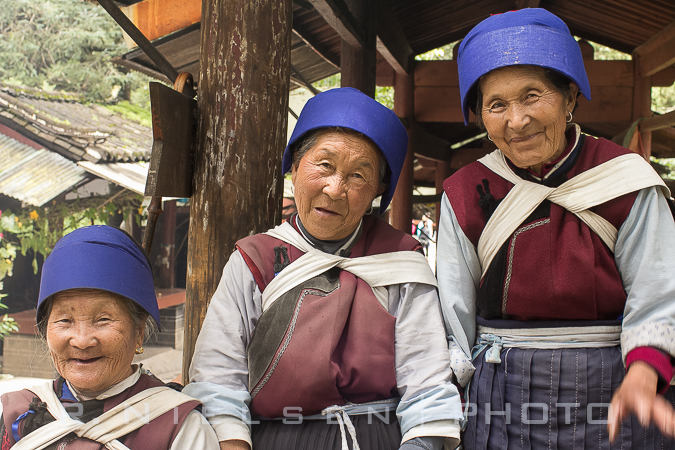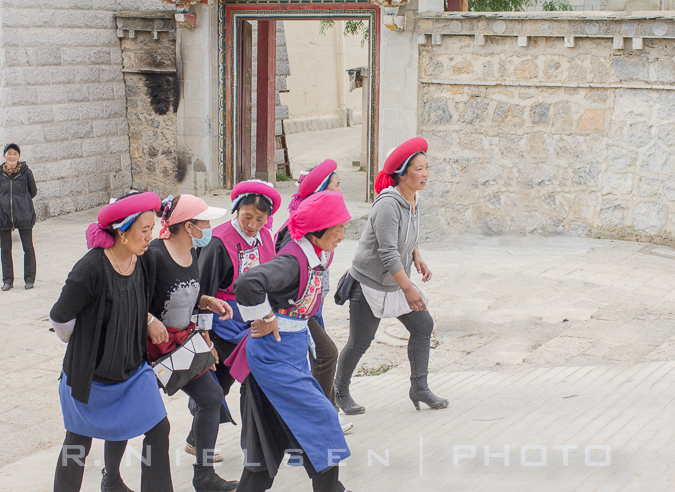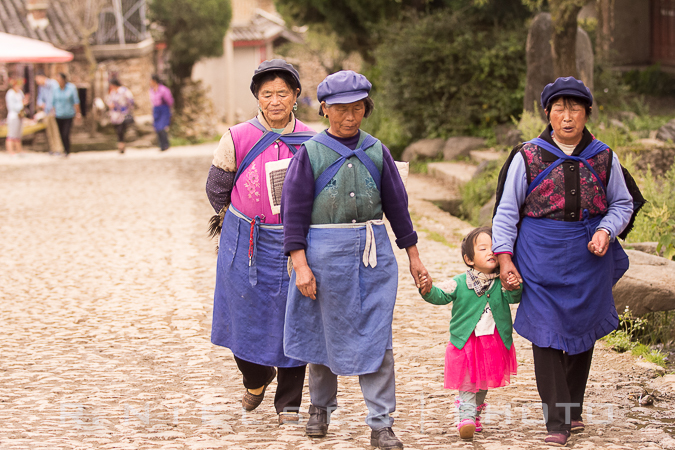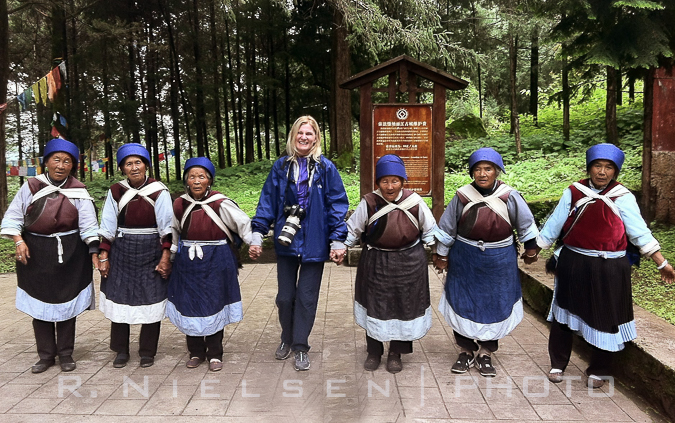China’s Naxi and Mosuo Societies: Where the Women are in Charge

 Both Naxi and Mosuo use their matriarchal status to attract tourists and business to their villages. Some 38% of Yunnans’ province’s population are members of minorities. Some groups, such as the Mosuo, who China recognizes to be part of the Naxi, have in the past claimed official status as a national minority, and are now recognized with the status of Mosuo people. There is a bit of controversy around their status as a separate society and whether the current matriarchal title should be honored.
Both Naxi and Mosuo use their matriarchal status to attract tourists and business to their villages. Some 38% of Yunnans’ province’s population are members of minorities. Some groups, such as the Mosuo, who China recognizes to be part of the Naxi, have in the past claimed official status as a national minority, and are now recognized with the status of Mosuo people. There is a bit of controversy around their status as a separate society and whether the current matriarchal title should be honored.
The Naxi forefathers were a nomadic clan of Qiang people from north China. They migrated southward to Yunnan and settled there. According to historical documents, the forefathers of the Naxi people were closely related to a tribe called “Maoniu Yi” in the Han Dynasty. But the designations they used to describe themselves as an ethnic group depended on the region in which they lived, i.e., to which enclave they belonged. The term used might be “Na,” “Naxi,” or “Mosuo,” depending on this geographical distinction, though there is some debate over whether the people calling themselves Mosuo are indeed Naxi, or perhaps belong to a different nomadic tribe originating in Tibet (the Mosuo, in contrast to the other Naxi, form a matriarchal society).
At the age of 13, after being initiated, females may choose to take lovers from men within the tribe, having as many or as few as they please over their lifetime.

The Naxi that I visited have been listed and registered with the Mosuo ethnic minority group which are located further west near the Tibetan border on Lugu Lake. Because the Chinese government have recorded and registered the two culturally distinct societies under a single enclave many foreigners traveling to the Lijiang area are misled into believing they are one in the same matriarchal group.
Does a matriarchal society exist in Lijiang’s, Naxi villages or is the systemize society further west? In the Yongning region near Lugu Lake, high in the Himalayas near the Tibetan border a small matriarchate has gained notoriety amongst photographers, authors and film directors.
What makes the Mosuo society so unique compared to the Naxi is the practice of zuo hun, or “walking marriage.” At the age of 13, after being initiated, females may choose to take lovers from men within the tribe, having as many or as few as they please over their lifetime. Male companions are known as axias and spend their days carrying out jobs such as fishing and animal rearing, and visit the women’s homes at night, often secretly; any resulting children are raised by the woman’s family. The father and all adult men are known as “uncles” – there is no stigma attached to not knowing who a child’s father is.

Tourism is booming, and the Chinese government is keen to market and fully monetize the Mosuo society for Chinese tourists, even installing a toll booth charging $5 to enter the Lugu Lake area from the newly laid main road (which was under construction a month ago when we were visiting and we were unable to reach the Lake). Lijiang and the surrounding villages are more conveniently accessible for tourists to visit compared to the secluded Lugu Lake.
But, history dating back to the Tang Dynasty (618-757) read that China was once ruled by a woman named, Empress Wu Zetian.
Listing the Naxi and Mosuo as one in the same might appear as clever administrative marketing or exploitation of poor migrant farmers–specifically the female gender. Myth has it that curious and frisky visitors are lured in by the suggestion that the Naxi/Mosuo women offer free sex – hotels, restaurants, casinos and karaoke bars have been built, and sex workers shipped over from Thailand dress in Mosuo traditional dress in the “capital village,” Luoshu.
Two thousand years ago, China’s aristocrats were schooled in Confucianism. Confucianism is a philosophy which teaches that logic and reason can solve all human problems, and that rejects excessive emotion and superstition. Confucius believed women were too emotional and superstitious to be organized and create a harmonious society.
But, history dating back to the Tang Dynasty (618-757) read that China was once ruled by a woman named, Empress Wu Zetian. She was a concubine who gained power after serving Emperor Tai Tsung and bore him several sons. During her reign, she challenged Confucianism placed Buddhism over Daoism as the favored religion. Female power has not existed in China since.

One might be met with disapproval to mention the latter to a Naxi and Mosuo woman. The Mosuo themselves often use the matriarchal classification and also believe it increases interest in their culture and thus attracts tourism. The term matrilineal is sometimes used, and, while more accurate, still doesn’t reflect the full complexity of their social organization. In fact, it is not easy to categorize Mosuo culture within traditional Western definitions. They have aspects of a matriarchal culture: women are often the head of the house, inheritance is through the female line, and women make business decisions. However, unlike in a true matriarchy, political power tends to be male dominated.
But for the moment everyone I have spoken to from the north to south; east to west of Yunnan has a preconceived notion that the Naxi and Mosuo are one in the same.
Women are often the head of the house, inheritance is through the female line, and women make business decisions. However, unlike in a true matriarchy, political power tends to be male dominated.

The photo of me dancing with the group of Naxi is the ceremonial coming of age dance. ‘Putting on Skirts’ ceremony is a Naxi coming-of-age ceremony for girls. When a girl reaches the age of 13, she usually attends this special ceremony intended to signal the transition to adulthood. Two days before the New Year celebration, the girls participating in the ceremony get together to sing, dance and drink wine and tea, as a means to congratulate each other on having arrived at this stage in their lives.
Early morning, New Year’s Day, each mother helps her daughter put on a new dress and jewelry. Then the girl joins the rest of the family and guests, where she sings together with the senior member of the family and expresses her gratitude and respect for the family in rearing her. The senior congratulates the young adult-in-the-making on her health, her beauty and her capabilities. Finally, all guests present gifts to the girl. Having completed the ceremony, the young adult can participate in adult activities, choose and meet with a boyfriend.
China’s Naxi and Mosuo Societies: Where the Women are in Charge photos by Unsplash and Rita Nielsen.









Hi, I read your article with interest having just spent some time in the company of the Naxi. I was informed that they were matriarchal but I noticed only males can be shamen and are in charge of the dongba religious practices and writing. Thus, to my eyes, they are a patriarchal society since real power, not household power (control of the household purse often lies with women) is clearly in the hands of men. Our very nice Naxi guide told us the women are hard working and do everything whilst for men, ‘it is a paradise’, they can sit around and smoke and drink, though the guide added that things are becoming tougher for men. This set up I also experienced in mountain villages in Vietnam, with the women carrying vast burdens of work. So, there may well be matriarchal elements (as there were in traditional societies) but real power lies with men. What a lovely place and fascinating culture, that said.